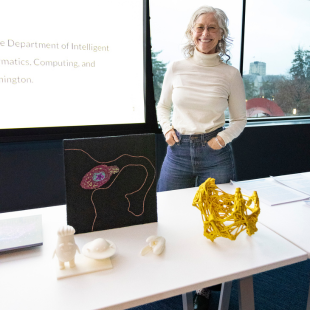
Collaborations between science, engineering and art can generate world-changing innovations, and stunning visual proof came during a recent presentation by Katy Börner,Luddy School of Informatics, Computing and Engineering Victor H. Yngve Professor of Engineering and Information Science, at Indiana University’s Sidney and Lois Eskenazi Museum of Art.
Artists, scientists, and data engineers gathered to view a collection of artworks, paired with their natural inspirations, that showcased multiple ways that art, science, and engineering can be motivated by an appreciation for biological processes and the beauty of the natural world across multiple scales.
The exhibits are currently displayed on the fourth floor of Luddy Hall.
“Collaborations across art, science, and engineering lead to innovations that are larger than the sum of parts,” Börner said. “That makes it possible to tackle the grand challenges we are facing so we all live desirable futures.”
Börner and her team at the Cyberinfrastructure for Network Science Center research, develop, and serve innovative methods and tools to model and visualize data from science, technology, biomedicine, education, and public policy.
That’s highlighted by their seven-year development of the Human Reference Atlas, a source of harmonized biological data designed to help biologists better understand health and disease, guide pharmacological development, and increase our understanding of how human bodies function.
Börner’s presentation featured impressive work such as CeCe and Squiggy by Todd N. Theriault, Melanie B. Goldstone and Shouvik Maiti; Capillus Linus (Hair Line) by Carrie Longley; Tabula Floris by Luke Nikolov; Beauty is Everywhere by Angela Caldwell; and Molecular Galaxy by Beata Edyta Mierzwa.
Theriault is a technical writer for the Cyberinfrastructure for Network Science Center. Maiti is an IU Data Science student. Goldstone is a freelance UX designer based in Germany. Longley is an assistant professor of Fine Art at Indiana University East. Nikolov is an IU assistant professor of Biology. Caldwell is a visiting assistant professor of metalsmithing and jewelry design at IU. Mierzwa is a molecular biologist at the University of California San Diego and the Ludwig Institute for Cancer Research.
Börner, whose research explores the frontiers of data visualization, said the presentation led to a fascinating discussion that “provided fertile ground for developing future collaborations.”

